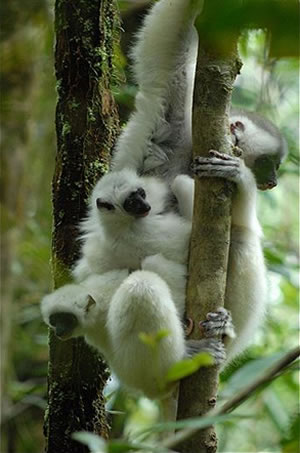Madagascar, the fourth largest island in the world, is famous for its unique wildlife.
The island of Madagascar, which is located off the southeastern coast of Africa, is 1,570km (976mi) long and has a maximum width of 569km (355mi). Only Greenland, Borneo and New Guinea are larger.
Madagascar consists of three north-south zones. A broad central plateau rises to an altitude of 1,400m (4,500ft). Tropical rain forest lies in the east, while the west contains mixed, rolling woodland.
Mountains along the east coast reach 3,000m (10,000ft) in height. Warm, moist winds sweeping in from the Indian Ocean deposit their rain on the mountain slopes and, in doing so, help maintain a coastal belt of rain forest, 50km (31mi) wide, which runs almost the entire length of the island.
In the west, a band of deciduous forest between 100km (60mi) and 200km (125mi) wide undulates down to the coast. As the broad, winding rivers of the region approach the sea, their brackish estuaries develop into dense mangrove swamps.
A semi-desert region, known as the Land of Thirst, lies in the far south of the islands. This region has are no rivers, and mountains provide a barrier that prevents winds from bringing rain to the land.
Wildlife of Madagascar
Ninety per cent of Madagascar's animals and plants are unique to the island.
An ancient continental shift, about 60 million years ago, separated Madagascar from the continent of Africa, isolating the island from the rest of the world.
The animals of Madagascar were able to evolve without being threatened by large carnivores.
Plant Life
A group of plants known as xerophytes can be found in the arid Land of Thirst. They have thick, spongy barks and can store large amounts of water to see them through times of drought. Xerophytes include the baobab tree, which appears to be growing the wrong way up (hence its common name of upside down tree) and the Pachypodium, which has a gourd-like bole and stubbly branches about lm (3.3ft) high
Forests of a xerophyte known as Didierea present a weird and menacing sight. Groups of slim, unbranched stems some 10m (33ft) high are heavily protected with thousands of tiny, razor-sharp spines. These spines prevent most herbivores from brows¬ing on the rows of leaves that grow between the prickles while trapping a layer of air to reduce the loss of precious moisture.
Animals
Madagascar is home to a large number of unique species of birds, frogs and chameleons.
The greater hedgehog tenrec, an insectivorous mammal that resembles a hedgehog, inhabits the dry forest and highland plateaus. Like a hedgehog, it rolls itself into a tight ball of sharp spines when it is disturbed.
The rice tenrec lives in Madagascar's paddy fields, where it feeds on invertebrates. It resembles a mole, with poor eyesight and the ability to burrow deep underground.
Lemurs
 Lemurs are a group of primates that can only be found in the wild in Madagascar.
Lemurs are a group of primates that can only be found in the wild in Madagascar.
The most well known lemur is the ring-tailed lemur, which has a long tail ringed in black and white. It lives in the dry, rocky south where there are some trees.
The largest lemur, the indri, measures almost 1m (3.3ft) in length; its bold, black, white and brown markings provide an effective camouflage in the dappled shadows of the forest. Unlike many other lemurs, the indri has a short, stumpy tail.
The sifaka, another type of lemur, makes its home in the Didierea forest.